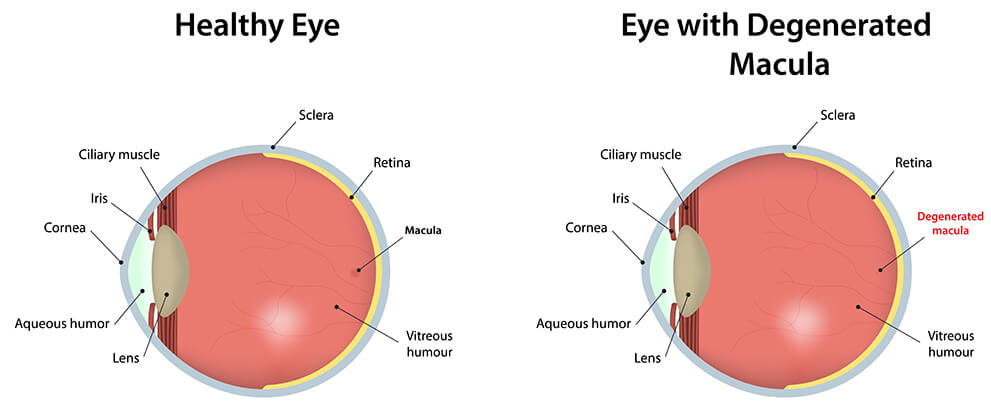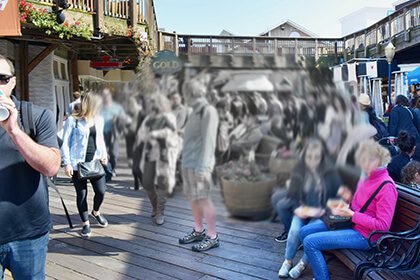Condition
Age-related Macular Degeneration (AMD) is the leading cause of vision loss and blindness in Americans ages 65 and older. The condition occurs when the macula, which is the part of the retina responsible for the sharp, central vision needed to read or drive, deteriorates. Because the macula primarily is affected in AMD, central vision loss may occur. There are two forms of AMD: wet and dry. Patients with wet AMD develop new blood vessels under the retina. This causes hemorrhages, swelling, and scar tissue. Dry AMD is much more common and is characterized by drusen (small, yellowish deposits) and loss of pigment in the retina.

Risk factors include:
- Heredity
- smoking
- blue eyes
- high blood pressure
- cardiovascular disease
Prevalence
1.75 million U.S. residents have advanced age-related macular degeneration. The number of cases is expected to rise to almost 3 million by 2020.
Symptoms

Macular degeneration usually produces a slow, or rarely, sudden painless loss of vision. Early signs of vision loss from AMD include shadowy areas in your central vision or unusually fuzzy or distorted vision. Retinal exams can detect early signs of macular degeneration before symptoms occur. When macular degeneration is suspected, a brief test to measure your central vision may be performed.
Treatment
Dry AMD cannot currently be treated, which does not mean you will lose your sight. Fortunately, dry AMD develops very slowly. Although you may lose some of your central vision over the years, most people are able to have normal, active lives, especially if AMD affects only one eye. Currently, Retina Institute of Hawaii is excepting enrollment for a clinical trial, which seeks a new care option for wet AMD. NeoVista’s Novel Wet AMD Therapy includes a one-time treatment of a targeted dose of beta radiation to leaking blood vessels and two injections of anti-vascular endothelial growth factor. Other treatment options for wet AMD are also available.



April is Sports Eye Safety Month, and we're here to remind you that your eyes deserve protection in all of life's games. Whether you're a professional athlete or a weekend warrior, we have the protective solutions to keep you in the clear. 🏈🕶️ #SportsSafety #protectyoureyes #bennetteyeinstitute #lovelife ... See MoreSee Less
0 CommentsComment on Facebook
In celebration of World Health Day, we're shining a light on the integral role of eye health in your overall wellness. Regular eye exams are key to catching not only vision issues early but can also even be the first sign of other health concerns. Schedule your eye exam at any of our seven locations across the islands. 🌎👁️ #WorldHealthDay #eyeexamessentials #bennetteyeinstitute #lovelife ... See MoreSee Less
0 CommentsComment on Facebook
🌑✨ We're gearing up for an awe-inspiring celestial event - we can view a partial solar eclipse across the islands on April 8th! While it's a rare and exciting moment, it's crucial to protect your eyes. Looking directly at the sun, even during an eclipse, can cause permanent eye damage. Use eclipse glasses that meet the ISO 12312-2 international safety standard, consider pinhole projectors as an alternative method for indirect viewing, and remember, regular sunglasses don’t offer sufficient protection against the sun’s rays during an eclipse. 🌌🔭 #SolarEclipse2024 #EyeSafety #EclipseGlasses #ProtectYourEyes #AstronomicalEvent #BennettEyeInstitute #LoveLife ... See MoreSee Less
0 CommentsComment on Facebook
Think eating carrots is the secret to impeccable vision? Guess again! 🥕 We’re all about eye health, but let’s get one thing straight - our dedication to your vision is no laughing matter. Dive into real eye care with us. 🕶️ #AprilFools #NoJoke #EyeHealthMatters #Bennetteyeinstitute #LoveLife ... See MoreSee Less
0 CommentsComment on Facebook
🐰🌼 Hoppy Easter from our practice to all our wonderful patients! Wishing you a joyful and clear-sighted holiday! 🌸👀 #eyecare #happyeaster #visionhealth #bennetteyeinstitute #lovelife ... See MoreSee Less
0 CommentsComment on Facebook
Wave goodbye to winter and embrace the thrill of spring adventures 🌴✈️! Recent findings from RSC highlight a pivotal insight: 50% of adventurers are held back from fully enjoying activities like water sports due to the inconvenience of glasses or contacts. 😎 🏖️ Plus, a significant 55% agree that having clear, unaided vision could profoundly enhance their travel experiences. How much could clear vision transform your adventures? 🌍💬 #ClearVision #AdventureReady #SpringTravels #rscsurvey #bennetteyeinstitute #lovelife ... See MoreSee Less
0 CommentsComment on Facebook